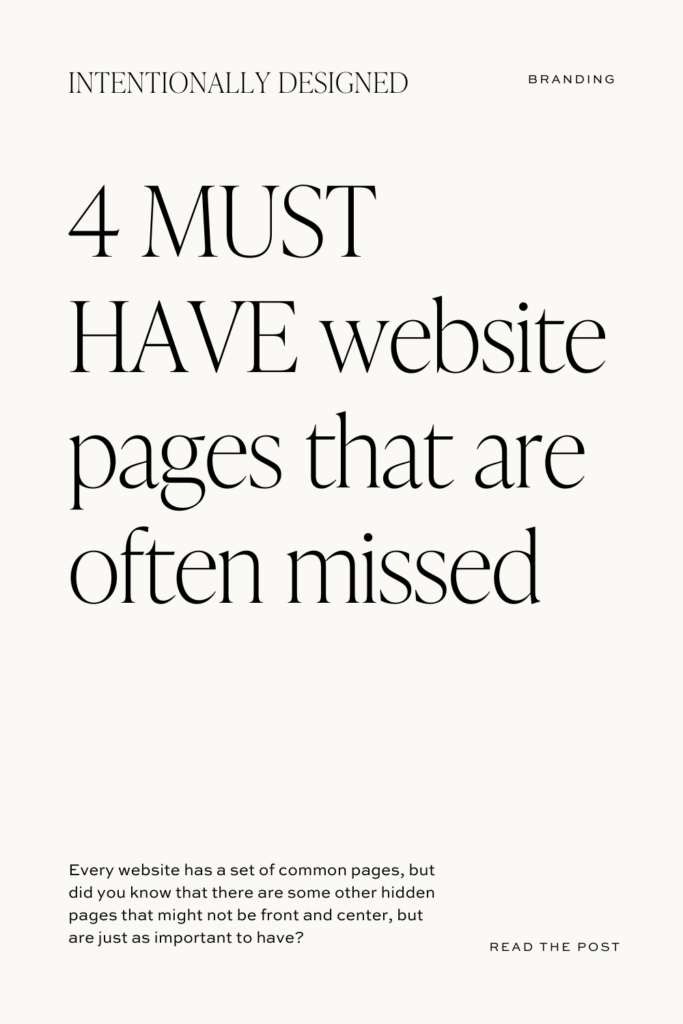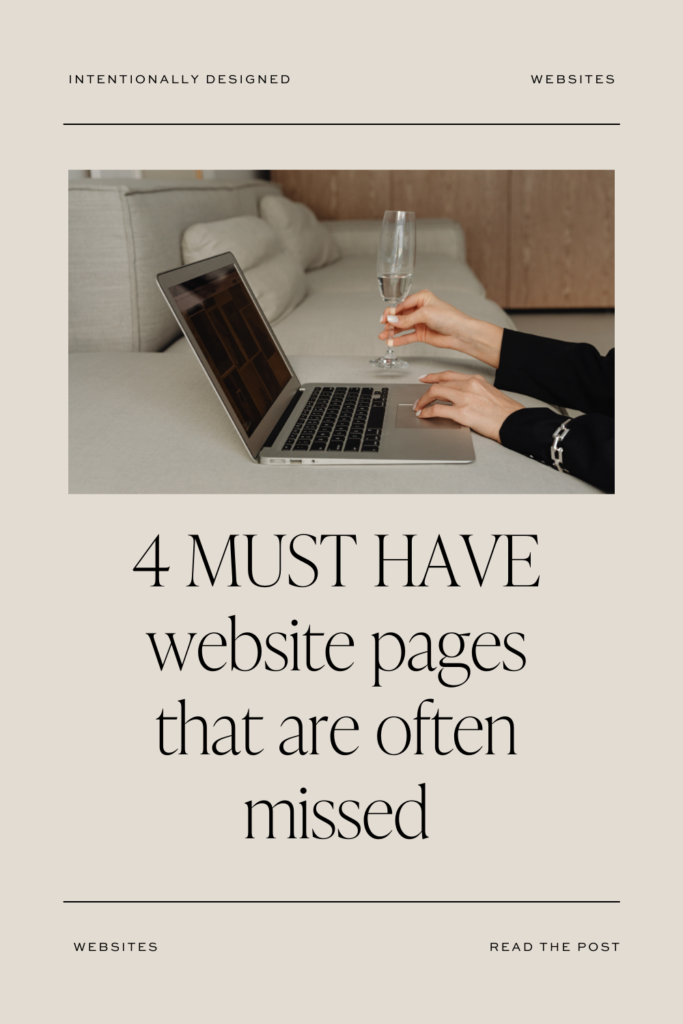Most websites include the standard pages like home, about, contact, etc. Almost every website has those pages and they are probably the first to come to mind when building your site.
But did you know that there are some other hidden pages that might not be front and center, but are just as important to have?
These pages are often missed or left off a website altogether so I wanted to break down these 4 important pages that you should have on your website and what they are needed for.
Legal Page
Every website needs to be legally protected and you do that by including a privacy policy and terms + conditions on your site. Essentially this is a page full of legal text that is typically linked from the footer area of your site. It’s super important to include but is often missed or forgotten. In fact, you could be violating federal law if you don’t have one.
A privacy policy informs your visitors what information is collected from them when they visit your site, how you use that information (ie: emails for your newsletter), and who else has access to the information (like your hosting company). The Federal Trade Commission (FTC) requires that any web page collecting information from consumers and/or that uses cookies have a privacy policy available to visitors. Not only is it legally required, but having one builds a greater sense of trust with your readers and makes you look more professional.
A basic terms and conditions policy tells people what they can and cannot do with your original content (like your photos, your content, or that cool idea you talked about in your last post.) If you also sell content, it can be extended to protect you in the event that someone wants a refund or shares your content illegally.
Just like the privacy policy, having a terms and conditions puts you on the level with your readers and consumers, lets them know that you’ve given thought (and care!) to what you’re doing and creating, and gives them clear instructions on how they can interact with your content.
Adding this to your site can be easy with an attorney-approved template that you can customize to your needs.
Instagram Links
You may have seen this one used before but might not know that it’s so easy to add to your own site. An Instagram links page is basically just a custom page on your site to house all the links you want to share from your Instagram link in your bio. Because Instagram only allows you to link from your bio and not individual posts, it’s helpful to have a full page where you can list multiple links instead of having the change the one every time you post something new on your feed referring to a link.
Most people will use something like LinkTree to create this page, but you can take this a step further with a custom page built directly on your site. This creates a better-branded experience and gets people to your domain versus sending them somewhere else first.
An Instagram links page will typically include a list of links that you can update as needed, but you can also include links to recent blog posts, a place for your lead generator or an email sign-up box, or links to your popular content. By utilizing a custom-built page on your site, you have more freedom to do what you want with it, but you want to keep it simple at the same time. You can think of it as a mini home page that focuses on the links you are referencing from your Instagram posts.
Opt-In Pages
Even with the most basic email marketing on your site (which is a topic we can cover in itself), you should at least have a general opt-in page and thank you page. This is a place where people can sign up to be on your email list. Typically they give their email address in exchange for something free (a lead generator), but even if they are just signing up for a newsletter, it’s helpful to have a page dedicated to this so you can use it to direct people to when needed.
It’s not something that will be linked from your main navigation, but still good to have so you can send people directly to your opt-in page and get them to sign up for your list. These opt-in landing pages can easily be created from any email list platform like Flodesk, but I recommend creating one on your site because it creates a more branded experience.
You also want to have a custom thank you page if possible that they are redirected to after they sign up. This keeps them on your site and continues the branded experience.
Custom 404 Page
A 404 page is a landing page that tells your site viewers the requested page is unavailable or, in some cases, doesn’t exist. When someone lands on your site through a broken link or is trying to get to a page that might have been deleted, they will be redirected to a 404 page. Most site platforms have a standard version of this but creating a custom 404 page for your site gives you the opportunity to control the info they see.
A standard 404 page will include some text about how they’ve reached a broken page with a way to redirect them, but a custom 404 page can create a branded experience that better helps them find what they were actually looking for. You can include a more branded message with links to your home page, popular content, or a way to contact you. You can also include a search bar so they can search for what they were trying to find.
Recap
Even the pages that aren’t front and center on your website can be important. In fact, I include all of these pages as a standard part of all website templates I create now because of their importance. Most of these pages can be created in a simpler and standard way, but by taking it a step further and creating custom versions on your own site, you are elevating your overall brand experience for the visitor and directing people to your domain.
Next Steps
If you’re missing some of these pages on your site, now is the time to add them. Whether your site is built in Showit, Squarespace, or Shopify, it is pretty easy to add these pages to your existing site and keep the branded experience going.
More Resources
- 3 Things that need to happen before you build your website
- How to DIY your website the right way
- How to plan and outline your website
- FREE Website Image Guide
- The Website Planner and Content Workbook
- Showit Website Templates
Save for Later
Enjoy this article and find it helpful? Pin this image on Pinterest so you’ll always have this info on hand!








